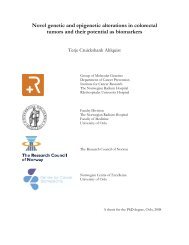Preface - Ous-research.no
Preface - Ous-research.no
Preface - Ous-research.no
Create successful ePaper yourself
Turn your PDF publications into a flip-book with our unique Google optimized e-Paper software.
Surgical Intensive Care Medicine<br />
tively. Plasma levels of several cytokines will be measured<br />
by ELISA (multiplex). Furthermore, blood was incubated in<br />
a whole blood model. The blood was first anticoagulated<br />
with heparin (25 U/mL) and incubated at 37°C with slow<br />
rotation in the presence of either Lipopolysaccaride (10 ng/<br />
mL blood), Peptidoglycan isolated form Staphylococcus<br />
aureus (1 µg/mL blood) or saline, respectively. At 0,1,4,6,12<br />
and 24 h, plasma was obtained by centrifugation and stored<br />
at -70°C. Levels of cytokines will be measured to further<br />
assess inflammatory responses after laparoscopic and open<br />
surgery.<br />
Clinical data are recorded prospectively during hospital stay<br />
and at follow-ups 6, 12 and 24 months postoperatively.<br />
Determination of P.aerugi<strong>no</strong>sa virulence .<br />
Pseudomonas aerugi<strong>no</strong>sa (PAER) is an opportunistic bacterium<br />
which seldom cause disease in healthy individuals. But,<br />
the increasing number of immu<strong>no</strong>compromised individuals<br />
has provoked a rise in PAER infections. In vitro determination<br />
of PAER virulence is complicated, and the current gold<br />
standard is a C. elegans killing assay. The killing assay measures<br />
relative virulence of PAER serotypes, but a major drawback<br />
is that it’s time consuming and resource demanding.<br />
In collaboration with Department of Infection Prevention<br />
headed by Egil Lingaas, MD, we investigate markers of the<br />
innate immune-response as an improved alternative to the<br />
established assay.<br />
Clinical isolates of PAER from patients with bacteremia were<br />
subjected to comparative evaluation in both the established<br />
killing assay and a well-established human whole blood<br />
model.<br />
Due to variation in individual response in human whole<br />
blood model we decided to use a cellular model: THP-1 cell<br />
line. The viability assay confirmed the differences in virulence<br />
of the strains tested on C. elegans, whereas the highly<br />
virulent strains for C. elegans reduced significantly the<br />
viability of the cells during the assay. The expression of host<br />
factors of innate immu<strong>no</strong>logical response is currently being<br />
investigated to establish a better understanding of host/<br />
pathogen interactions and to identify host factors mediating<br />
susceptibility or resistance to virulent PAER isolates<br />
Studies on possible effects of a newly developed hemapheresis<br />
filter (TM100) on inflammatory mediators and<br />
hemodynamic parameters during experimental endotoxinemia<br />
in pigs.<br />
Therapy in sepsis is still greatly discussed due to a high mortality.<br />
Lipopolysaccaride (LPS) is a main initiator of cascade<br />
chain reactions during gram negative sepsis that may lead<br />
to multi organ failure, circulatory collapse and eventually<br />
death. There are some few publications concerning possible<br />
positive effects using hemofiltration in humans during<br />
severe infections. We have started to test a newly developed<br />
hemofiltration filter (TM 100) in anaesthetized pigs during<br />
ongoing LPS infusion. Twelve heparinised animals have<br />
been used during 2010 to look for an optimal filter content<br />
and experimental model. The filter device was placed in the<br />
inferior caval vein. We have searched for criteria for possible<br />
effects on different parameters.<br />
Results so far have revealed a systemic reduction in the<br />
TNF-α concentration by 30%. During ongoing hemofiltration<br />
an initial drop in systemic blood pressure was detected<br />
but could be reversed after intrave<strong>no</strong>us saline. Further studies<br />
comparing effects of different hemofiltration systems<br />
are planned.<br />
The C. elegans killing assays optimized by Reza Assalkhou,<br />
PhD, (Dep. of Infection Prevention) showed that this assay is<br />
highly reproducible and can differentiate between strains of<br />
PAER with high, moderate and low virulence respectively.<br />
The ex vivo whole blood model to study the inflammatory<br />
response by measurment of the cytokine production of<br />
leukocytes was used. Testing blood from 3 different persons<br />
clearly indicated the variation in regulation of cytokines<br />
production between these persons in response to bacterial<br />
infection.( IL (Beta, Ra, 2, 2R, 4, 6, 7, 8, 10, 12, 15), TNF-Alpha,<br />
INF-Alpha, INF-Y, GM-CSF, MIP (1Alpha & 1Beta), IP-10, MIG,<br />
Eotaxin, RANTES, MCP-1, G-CSF, FGF basic, HGF, VEGF).<br />
12
















